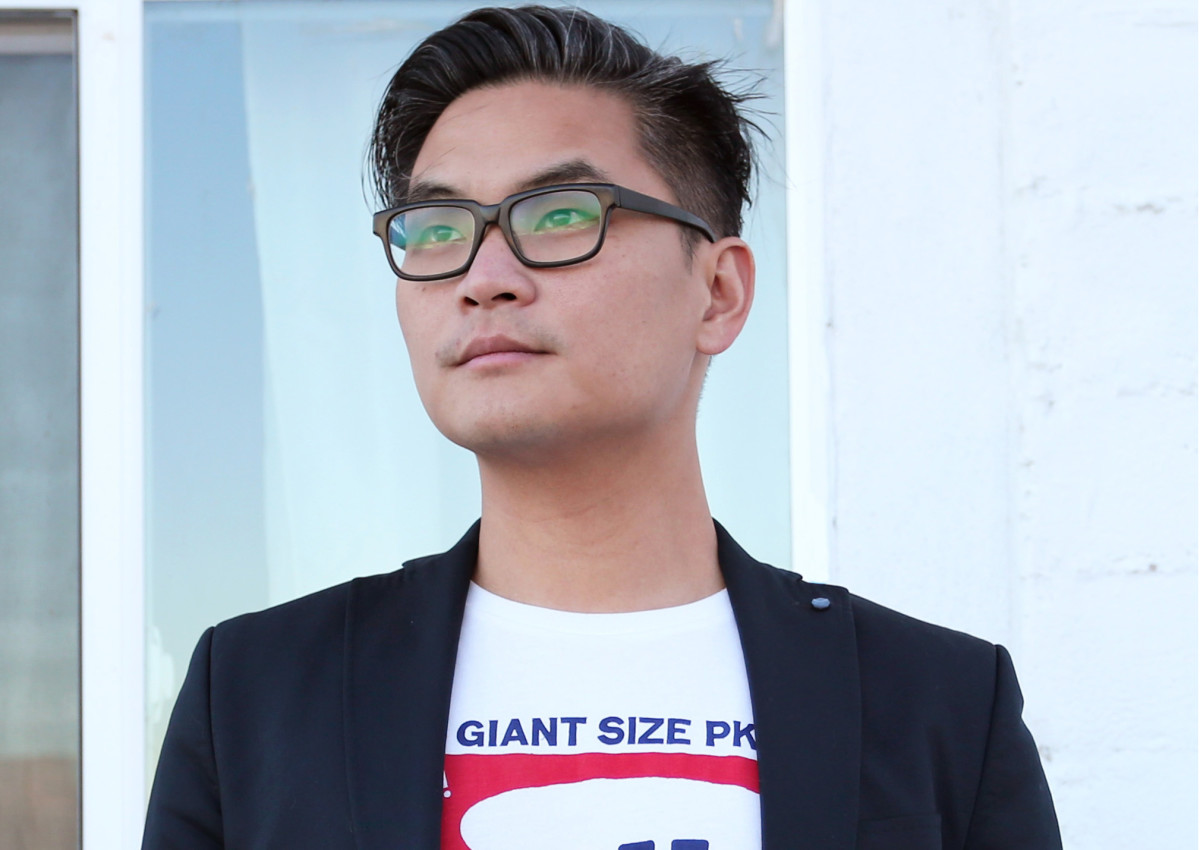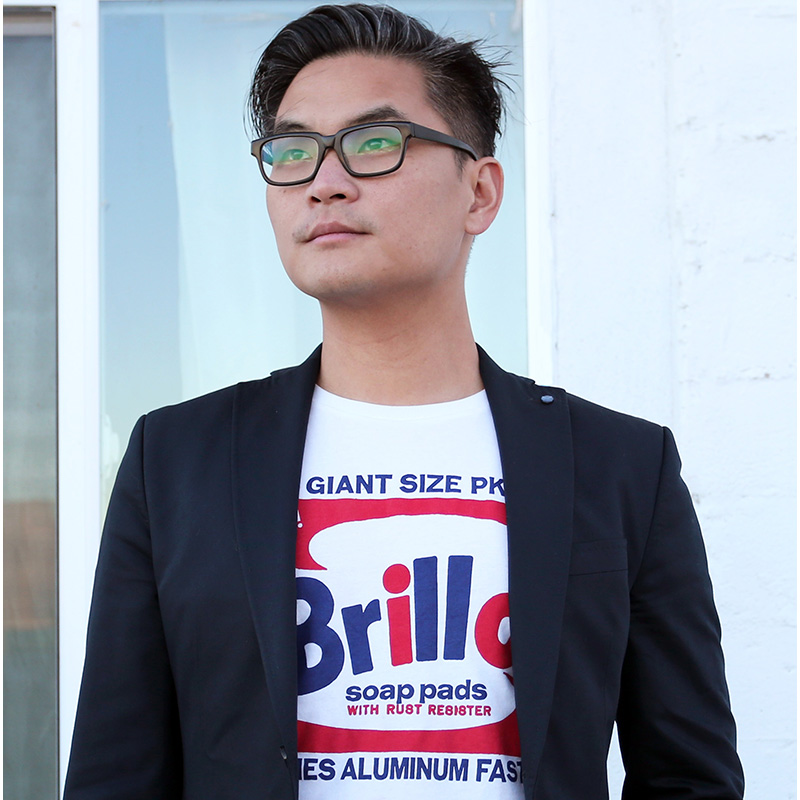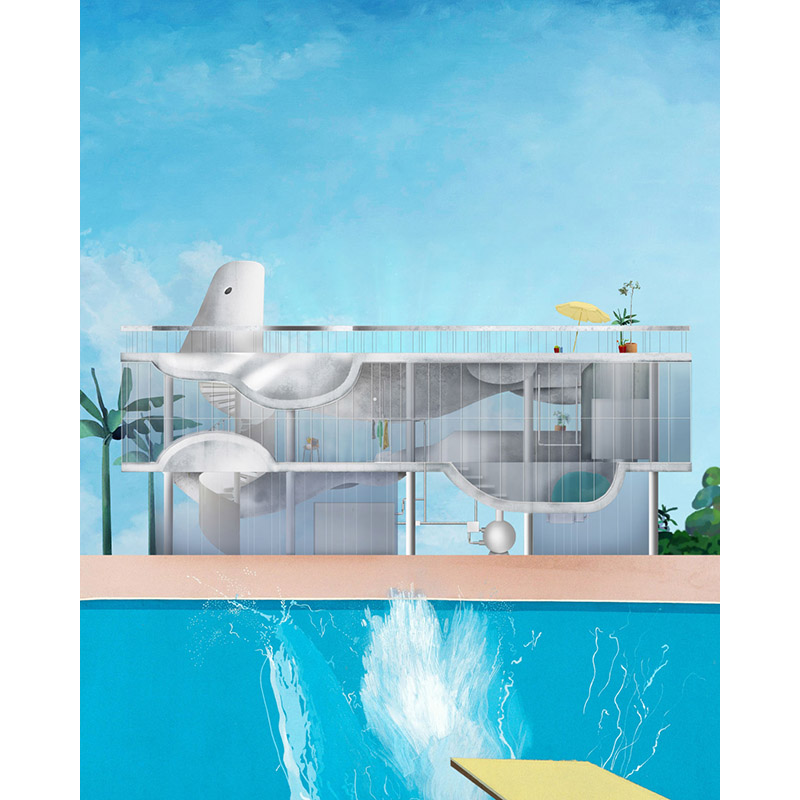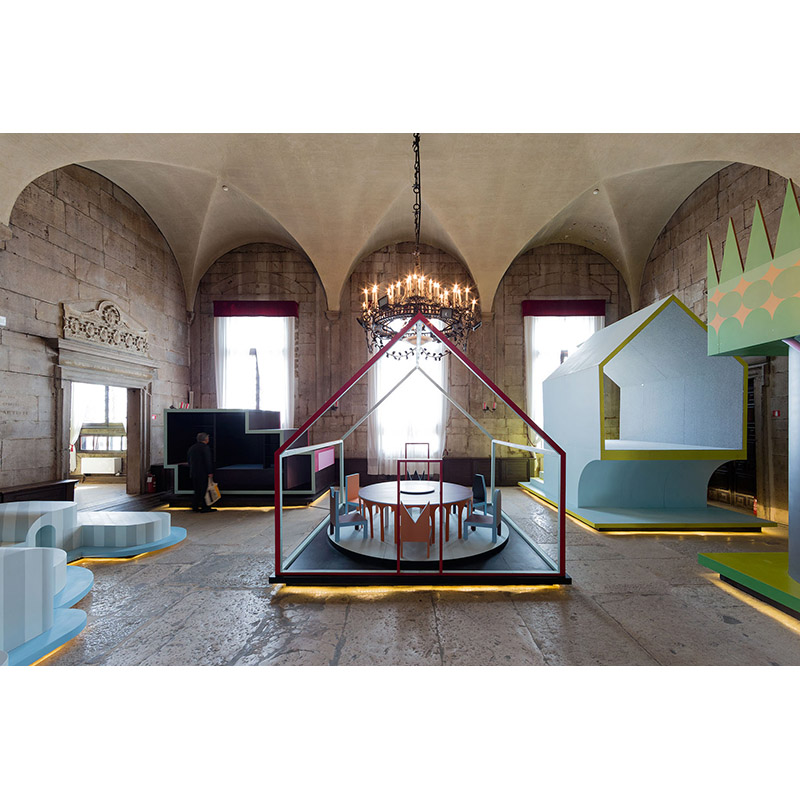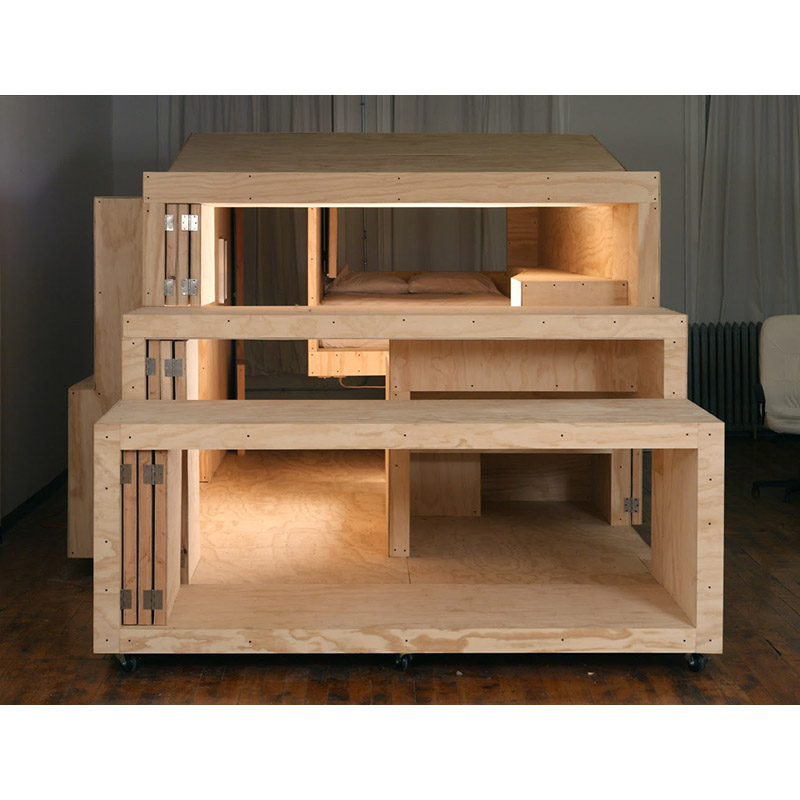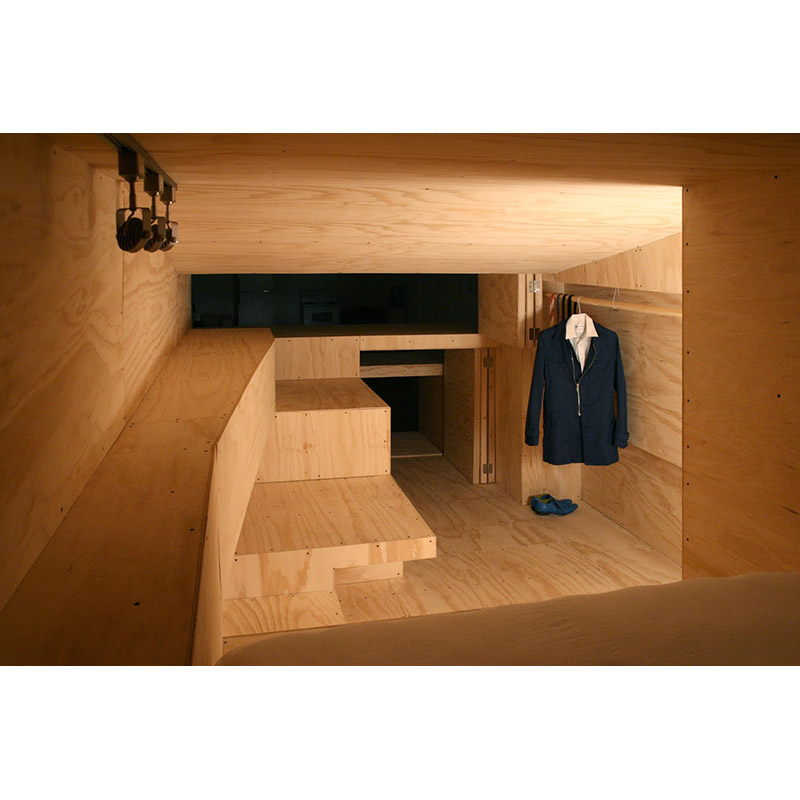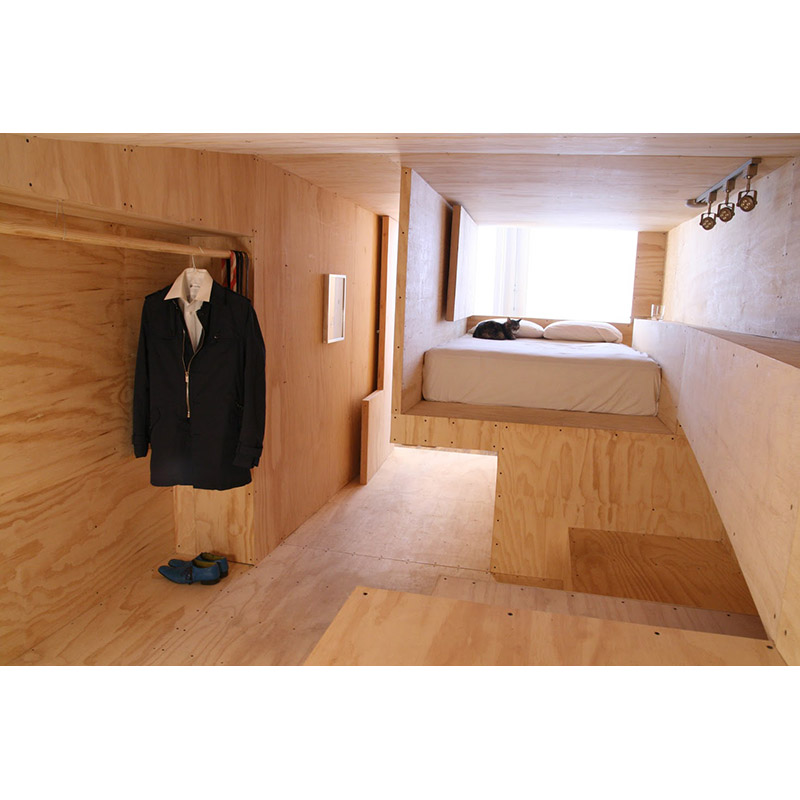Language is a systematic, conventional resource used for unique, independent expression. It can be thought of as a constantly fluctuating technical entity that manages to function in a rational way. Yet language develops not through rationality but through deviation. Spoken and written word progress—much like architecture, music composition, and other structured creative modes of representation—because the rules submit to being broken.
Jimenez Lai founded Bureau Spectacular in 2008. Lai describes his studio as “an operation of architectural affairs,” distinct from an architectural firm in that Lai and his team are less concerned with planning, designing, and building physical structures than with developing an architectural language that is autonomous, intuitive, and anti-systematic. In Lai’s work, a physical structure arises from a narrative and Bureau Spectacular’s programming “engages the design of architecture through telling stories…stories about character development, relationships, curiosities, and attitudes.”
Lai was born in Taiwan and moved to Toronto, Canada, in 1991. He studied at the University of Toronto and received a bachelor of arts in 2002. Over Skype last week, Lai told me he didn’t major in architecture as an undergrad because it seemed like “a rite of passage in North American education to learn from multiple sources.” Instead, he majored in art history and took classes in cinema studies and sociology, which have had “huge impacts” on his architectural practice. In particular, Lai has carried with him “the cognitive cause and effects of how to tell a story”—he learned these from animation, an ongoing passion and talent—into designing interior and exterior space. He did receive formal architectural training at the University of Toronto as a master’s student, and is currently a faculty member at UCLA’s School of Architecture and Urban Design.
For Lai, architecture is a means of communication; the tangible, material end derives its value from its ability to “speak.” In Township of Domestic Parts, his project for the Taiwanese Pavilion at the 2014 Venice Biennale, Lai and his team created structures that functioned as one architectural program allowing for other attributes to be explored, such as the character and personality of a space. Lai has also authored a graphic novel, Citizens of No Place, organized the Treatise publication series—a collection of individually authored books by fourteen emerging design offices—and published numerous articles over the last five years.
Lai not only draws inspiration from sources that engage both text and image—theory, criticism, formal design, and comics—but often deploys concepts in his work that traditionally belong to literature, like character development, relationships, and attitudes. In this way, Lai is not only rigorously pursuing a professional inquiry into structure and aesthetic, he is writing his own language.
—Elizabeth Karp-Evans for Guernica
Guernica: Can you describe how you see architecture as a form of cultural communication?
Jimenez Lai: I see architecture as a form of communication over time. What’s interesting in archaeology is that we always understand other cultures by digging up their cities; architecture is almost always a way for us to formulate a diagram of how people used to live. It’s also a communication beyond languages. If I were to arrive at a foreign country like Czech Republic, I don’t have to speak Czech to understand the feeling of the local sensations through architecture. That is a kind of communication that no language can perform.
Guernica: What was your experience studying architecture? Was your thinking already aligned with the popular ideologies or practices in architecture during that time?
Jimenez Lai: When I would present my work as a student, often I would hear, “Your project is too formal”—it’s too form-based; it’s too form-driven. Which is kind of shocking for a visual practice, for someone to say something discouraging about a focus on an exploration of aesthetics. The exploration of aesthetics was discouraged, but I can understand that, because architecture, in itself, at the end of the day, is a rational profession. It’s definitely one of the more rational arts. You’re forced to deal with people investing millions of dollars on buildings, so it has to be objectively functional.
I think in a space of imagination, which universities represent, that was something that I didn’t expect: the resistance to aesthetics. For example, we were encouraged to diagram maps, to study resources and understand urban densities and so on—there was this strange myth that form would be derived somehow magically, automatically, by the study of information and without the will of the individual. Aesthetics is both politics and philosophy, a series of agreements and disagreements between subjective minds. As a visual discourse, architecture requires trained individuals to work on the refined philosophical debates. School gave me the necessary training, and I’ve built on this based on my own aesthetics, as most do.
Morphology happens over time. It’s not necessarily a bad thing.
Guernica: Language is increasingly being formed in the same way: by the rational, almost reductive absorption of information. I’m thinking of very abbreviated platforms like Twitter, text message, and GChat—is our language changing based on data from these platforms?
Jimenez Lai: The idea of morphology of languages is something that I’m really interested in. How does German turn to Dutch, and how does Dutch turn to Anglo-Saxon and eventually English? As you say, morphology is actually taking place through things like Twitter or GChat today, where we’re changing how things are spelled, and those spellings are accepted as standard now. Morphology happens over time. It’s not necessarily a bad thing.
I think of architecture as language, and I look within the intra-communication between architects. In order for architecture to experience its ongoing evolution as a language, there has to be a lot of adjusted copies between how architects draw, think, engage bylaws and constraints.
Guernica: Do you see distinct architectural languages as merging or morphing because of globalization?
Jimenez Lai: I think so, yes. I think regionalism was a little easier before mass communication was made possible. This is not to say that regionalism doesn’t exist anymore. I think it does. Every time I traveled to a new city, I would learn about local heroes I did not know about, and I would learn about their very impressive contribution to their cities. There are nuanced senses that only people from the region can understand, and no amount of globalization can change that. It’s almost like a maxim of a sorts, when you think about language, the way that people speak in a location. It does happen with architects, in terms of how they engage cities.
But the morphing of languages happens on the Internet, too. My friend Andrew Kovacs is an example of this. He’s an architect, we’re teaching together right now at UCLA. You could say that one of his architectural instruments is the Internet. There is a very interesting relationship that he’s managed to build. As the greatest crate-digger of our times, he would go to libraries and scan images of rare [architectural] finds or, as he would call it, “B sides,” and put them on Tumblr or Instagram. He calls his project the Archive of Affinities—building an archive on the Internet. I think his [project] is beginning to influence the closeness of architectural language over great distances of time and space.
Guernica: Architecture, like language, seems to depend less on technical practice than it once did, based on this shift to digital platforms. Do you think the Internet, whether we’re utilizing a search engine or sending communication, allows for greater inventiveness in language?
Jimenez Lai: Communication requires cultural context, and technology facilitates our ability to cross-reference ideas over time. There was a time when people like Robert Venturi, or Denise Scott Brown, or Charles Moore were saying: Enough with the sterile, context-less architecture. Enough with the functional-minded frame of operation. How about a little mess? How about a little, let’s say, syntax? A little quotation using history? How about some other meanings or symbols? I think that’s the only logical reaction when you have to thoughtfully manage the communication of a lot of information.
Guernica: So language is morphing at a quicker rate today than ten years ago because the Internet is creating an excess of information—the ability to access multiple points of context to extract meaning?
Jimenez Lai: Probably. I was recently learning about the Caught-Cot Merger in the American English language, which is happening right before us without most of us realizing. In certain areas of United States, the pronunciation of “caught” and “cot” are still distinct from one another, but this isn’t the case once you move west of the Colorado Mountains. The two sounds are becoming the same, and it has more to do with the merging of “o” and “augh” sounds. There are probably other instances that I am unaware of. But the Internet has expedited the process of abbreviation of many words and even a reemergence of hieroglyphics in the spelled-out emoticons. This has less to do with the architects over-reading the Internet [and more with] a natural gravitation toward convenience.
Guernica: Is it also about the idea of simplicity—breaking things down into individual objects or words as a result of an overload of information? Is architecture, language, design, and so on moving toward more simplified, more modular ideas?
Jimenez Lai: Brevity is a great technique in communication. One of the very interesting approaches in architecture today is led by some of my colleagues like Kersten Geers and David Van Severen. They’re super-fantastic Belgian architects whose worlds are really clean, a kind of well-choreographed austerity to how hardcore normal can be. It’s really quite beautiful. You can maybe say something similar about First Office, Productora, or Johnston Marklee. It is like a writer being meticulous with the choice of vocabulary, a well-designed arrangement.
Guernica: Can you talk a little about your project for the Taiwanese Pavilion at the 2014 Venice Biennale?
Jimenez Lai: The name of the project is Township of Domestic Parts. In a normal domestic environment today, the architectural program of a house is compartmentalized: a kitchen, bedroom, living room, bathroom—we’re looking at these separations of subdivided units within the domestic whole. What if we deconstructed [these units] from the whole so that the parts might become a collection of free-standing, single-program architecture, and there can be no further subdivision to its program? Each part would have one function, and they’re all buildings in themselves. [A bedroom] is one program, and that is sleep. The dining room is a building; the bathroom is a building. If we scatter this single-program architecture inside of a domestic environment, we can link an interior urbanism in a way similar to a village or a township of tiny houses.
That was the beginning. We first developed the programmatic characters that way; we were also looking at the single-program, free-standing architecture as characters. By “character,” we mean both a possible well-designed work of typography as well as a well-developed personality in a story arc. We wanted to apply color as a way to insinuate their personalities and characteristics. What if architecture had personalities in addition to having character? And what if these qualities are implied, not expressed? For us, it’s important to write a mystery novel where the takeaway is not a giveaway—where something could be read over and over.
Guernica: A passage explaining the project reads: “Architectural program, particularly throughout the 20th century, has evolved into a highly specialized vocabulary in the composition of the interior, and at times it even impacts the exterior.” Can you think of some instances where this vocabulary may have been intentionally broken down?
Jimenez Lai: One of the houses that I really enjoy looking at and thinking about is View House in Rosario, Argentina. It’s possibly my favorite house in the twenty-first century. It’s designed by Mark Lee and Sharon Johnston—Johnston MarkLee [[with Diego Arraigada]. They’re Los Angeles-based architects. There is a relationship between the inside and outside of the View House, in that the diagram of this house is a loop that connects a series of functional parts on the inside, and the exterior massing indicates residues of the internal logic. The openings and windows also help communicate this interior diagram. The Kukje Gallery by SO-IL is another great example of this interplay between inside and outside, where interior function is suggested on the exterior as a collection of tight-fit protrusions.
The diagram of the house is a portrait of the family, a true portrait, whether it’s sad or happy.
My other favorite house—this would be the late twentieth century, not the twenty-first century—is the Miller House from José Oubrerie. José Oubrerie met a man named Mr. Miller who wanted Oubrerie to design a house for him. José quickly understood that there was a problem in the household, which is that the family had two grown sons who were not speaking to each other, as well as not speaking to the parents. Once José understood this, he started designing a house with three separate entries and exits—four if you count the actual entry. The house is three houses within one house that have their backs turned on the living room. The living room is this kind of vacant ruin, a city square that no one goes to. I find that a really compelling story, because it’s a biography that’s built as a physical work of architecture. The diagram of the house is a portrait of the family, a true portrait, whether it’s sad or happy.
In some cases there are ways of thinking about what an architectural program produces—interior and exterior—that is not necessarily directed by an economic requirement, but is a diagram based on human actions, selfish or otherwise.
Guernica: In 2010, you completed the Briefcase House, which has been described as “a house within a house, where all the material possessions are compacted into one oversized briefcase, which the subject sleeps inside.” You also lived there for a time. What was the story behind this project?
Jimenez Lai: For many months, during the time of the construction, I lived in this kind of sawdust-filled skeleton of an environment. I used to move around a lot until [I began teaching in] Chicago. Finally, I had a stable job and I rented a big space, about 1,400 square feet, and I said, “Okay, I’m going to build a house inside of this space.”
It was during a pretty turbulent time in my personal life where I was going through a separation with someone. I really felt like a shut-in. I wanted to find ways to paint stuff black, so to speak; it’s private and it belongs to me, no one was going to enter my private life. There would be a box I lived in and the intent was solid matter. I was also thinking that it was compact enough of an object that I could fill it with my private life.
It eventually evolved into this idea of super-furniture. I was thinking to myself: Is the Briefcase House architecture? I was thinking no, this is too small to be architecture, but too big to be furniture. That was the beginning of a train of thought. The idea of super-furniture emerged out of that project, which helped us develop the Township of Domestic Parts.
Guernica: Derrida talks about spacing, the idea that the present is defined by the same interval that divides it, splitting it from the language and substance that constitute it, creating a kind of potentiality—“the becoming-space of time or the becoming-time of space.” In a way, with Briefcase House, you composed an arrangement where you could only be in the present of each individual space in the house. Did time pass more slowly?
Jimenez Lai: It really did. I felt like my focus was accelerated. It was almost like a compression of time and space. It wasn’t so much that I was working extra hard, but that I was always working, always in the present tense. The obsession was so real and so prolonged. Sleeping was kind of like taking breaks from continuing the obsession.
Guernica: Where is the house now?
Jimenez Lai: We took it apart. It was so tragic, but I felt like it was important to make a change. The week after we took it apart, a museum asked if they could have it.
Unlike sciences, literature as art relies on societal acceptance of a certain vocabulary.
Guernica: Thinking along the lines of parts composing a whole, I’m wondering if poetry is an apt metaphor. The goal is not necessarily a coherent story but a beautiful composition of individual parts that work together, and are more legible together than individually.
Jimenez Lai: I’m thinking about the idea of poetic license. People say that about certain writers: “Oh, the grammar sucks, but it’s just the poetic license.” We accept it as being an art form of sorts: the incorrect rearrangement of meaningful things. Unlike sciences, literature as art relies on societal acceptance of a certain vocabulary. We’re just making sounds out of our mouths if we don’t both accept that what I’m saying has very significant meanings, and I’m accurately targeting what vocabulary I use and how I arrange each word.
To apply poetic license or to apply incorrect arrangements requires the idea or the understanding of correct arrangements—becoming an expert of the conventions of correct arrangements in order to misplace them. In other words, misplacing things with the understanding, or even the mastery, of normalcy is actually quite poetic. These are rule-based operations.
Architectural drawing is a language with conventions where the rules can be deliberately misused; a well-composed architectural drawing can both contain correct and incorrect arrangements of meaningful things.
Guernica: As technology advances, we have to speak less—communication through visual data has grown exponentially. Do you think the future of language is built environments?
Jimenez Lai: Maybe I’m talking about morphology of language again. In 500 years, English has changed a lot, and right now we’re undergoing an extremely rapid rate of accelerated advancement in terms of technology, but I still have a hard time believing that we’re going to stop speaking to each other. The role of architecture, in terms of communication, is not going to drastically change either. It’s going to continue to create a cultural affect where people will be able to understand something beyond function that may otherwise be foreign to them.
I don’t really know what’s going to happen 10,000 years from now. We’ve been biologically modern for, what, almost 200,000 years? Let’s go back to the cave paintings: I think the moment that someone landed a charcoal on a wall to describe reality, that’s language already—that happened on a vertical surface, which, even though they didn’t build it, somehow we could understand it as architecture because there’s a cavity that separates the inside and outside. That’s 40,000 years in the past.
Guernica: I guess it’s naïve to think that we will evolve beyond spoken language in a couple hundred years when people still use sticks and charcoal to make paintings.
Jimenez Lai: They do. No longer out of necessity, but out of joy.
Guernica: If you could communicate any narrative you wanted through architecture, what structure would you build?
Jimenez Lai: It’s really hard, because it’s more meaningful to tell a story that has a subject matter with constraints and source material for tension and suspense. I would have to choose a subject matter to tell. I’m interested in too many things right now, so it’s really hard to narrow down the one thing that I would tell. Maybe the narrative isn’t going to be told using just one structure. Maybe I can only answer this question by saying that I am working on a larger story by accumulating a body of work. Many artists I enjoy have a large body of work, and eventually the message is derived out from the sum of its parts. Johnny Cash may have recorded something like 700 songs, but there’s an idea of the story that he tells. Same with David Bowie, or Andy Warhol.
When it’s all said and done, it probably will be a body of work that tells a story. I don’t think I have a large enough one yet, meaning I have to roll up my sleeves and keep at it.
Guernica: Are there architects whom you feel have told a really comprehensive story through their work?
Jimenez Lai: There’re several architects I think about all the time. Le Corbusier is one of them. In terms of architecture as a medium, I think he challenged the boundary of where architecture resides, in terms of: Is it just bricks and mortar? I think for people in his generation, it’s also about writing, and he became somewhat of a representative out of sheer quality and mass.
Strangely, I think about Frank Gehry a lot. Maybe it’s not that strange, because he is a great architect. I understand that not everybody is thrilled about Frank Gehry—but I like Gehry in a similar way that I like Madonna or I like Picasso. There may be seven or eight Gehrys. He’s somebody who allows himself to undergo metamorphosis, so he will have different periods of his work. I really admire unwillingness to stick to a style, or allowing a blank sensibility to respond to the changes of culture. I think if Gehry aggressively pursued a style independent of listening to the culture around him, he may be a static architect that no one would even really want to pay attention to. As a dynamic personality with that kind of body of work, and especially the approach to building that body of work, his work, I find, is not only courageous but smart.
I think about Rem Koolhaas all the time as well. I believe architecture is a cultural output and I think Rem Koolhaas is one of the rare individuals who was able to really output architecture as cultural artifact. Maybe, again, through writing, publication, other forms of curation. I think, early in his career, he was a writer and a journalist. Early on, you could tell that he was very sensitive to changes in culture, and a close listener to culture. You could tell from the onset that he was a very close listener to quiet changes in the softwares and hardwares of culture.
It is possible to construct small realities that contain political or philosophical responses, not necessarily just practical or economical responses.
Guernica: Each of these architects also mastered language, to a certain extent. They could write about their process. How important is writing to your own work?
Jimenez Lai: I have to write quite a bit. The moment you put something down on paper it forces you to organize and arrange these thoughts a little better. I recently wrote a piece on comics in architecture—I was talking about the three kinds of comics I pay attention to: the Franco-Belgian, the Japanese manga, and the American comics.
Once I began to write these things down, and I started thinking about the relationship between Japanese manga and Japanese architecture, or Franco-Belgian bande dessinée versus Franco-Belgian architecture, it began to make sense; there are parallels to the modes of operations and the cultures they belong to. If I didn’t force myself to write, I would have no forum to clarify these thoughts. Writing is really helpful.
Guernica: What are some of the links between comics and architecture?
Jimenez Lai: For example, in understanding the speed of production in the Japanese manga industry, I began to appreciate the layout strategies of the graphic design. The part-to-whole relationship is often whole-heavy, so that the weight of the frames themselves aren’t carrying the entire message. It is almost a masterplanning of rooms before the design of the rooms. In the work of Japanese architects Toyo Ito and SANAA, you can find this kind of loose-fit confetti that fills whole before the parts. The Franco-Belgique approach, on the other hand, almost always takes us back to the filmstrip. The frame-to-frame relationship relays an idea of time that strengthens the role of the frame, rather than the page. When I think about Bernard Tschumi’s Manhattan Transcripts, or “House Merchtem” by Kersten Geers & David Van Severen, I see a storyline of Herge’s Tin Tin.
Guernica: Quite a bit of architectural study and thought concerns structures that will never be built, but there is still an investment in their possibility. Why is this?
Jimenez Lai: I think architecture could be understood as the construction of realities, or the construction of worlds. One of the reasons why architects are often attracted to philosophers, partially, has to do with making sense of the world around us as well as the making of worlds, and in our case, the realities we create can be as real as concrete. These kinds of ideas, of wild imagination, go into the question of how you make a world. When I was younger, I felt that feeling you were talking about: This is possible. It’s possible to say that the work of an architect is more than just getting buildings built. It is possible to construct small realities that contain political or philosophical responses, not necessarily just practical or economical responses. I find that very desirable. Unbuilt architecture, like the work of Superstudio or Archizoom, was never meant to be a set of functionally optimized buildings. But they built a set of realities that allowed readers to contemplate their own worlds. In that way, unbuilt work can be just as important as built work.
Guernica: Whose philosophy do you find relatable in terms of your work?
Jimenez Lai: Albert Camus is very relatable, especially the feeling that the world is meaningless, and joy being the only way to engage the world. The world is meaningless and therefore it’s funny.
Setting up absurd worlds with rules to violate—it’s one of the things I hope to achieve with my work.
